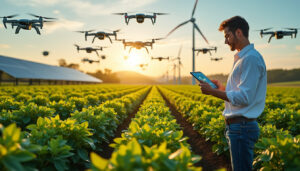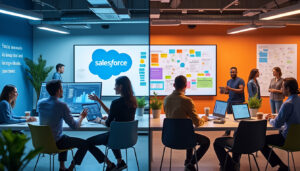In a constantly evolving world, companies can no longer simply meet their customers’ immediate needs. The key to their success lies in their ability to anticipate future expectations and adapt quickly to changes. For this reason, identifying emerging trends has become crucial for any organization wishing to stay ahead of the competition. This proactive approach not only allows for a better understanding of customers, but also for developing innovative solutions that meet their anticipated needs. Therefore, exploring tomorrow’s trends is essential for building a solid and sustainable business strategy.
Understanding Customer Anticipation
Anticipating customer needs is based on a rigorous methodology that combines data analysis, behavioral observation, and an understanding of underlying motivations. In this first section, we will examine the different aspects of this analysis.
A Proactive Approach
Anticipating customer needs is not a simple organizational task. It requires a proactive approach, where companies must look beyond explicit consumer demands and identify weak signals that could indicate emerging trends. Brands like Nespresso and L’Oréal have demonstrated this capability by investing in market research and predictive analytics tools to capture relevant signals. Analyzing quantitative and qualitative data In-depth market research to identify possible trends Using AI for pattern detection Signals of change To anticipate future consumer expectations, it is crucial to detect certain signals of change in their behavior. These signals can take several forms: Evolving product preferences
- Increased environmental concerns
- Changes in lifestyle and consumption
- For example, with the rise of online retail, companies like Carrefour and Decathlon must devise distribution strategies that make life easier for customers while addressing their sustainability concerns.
Anticipation scenarios
The ability to create anticipation scenarios is also a fundamental aspect of this anticipation. Using modern tools such as predictive models and simulations, companies can explore multiple possible futures and plan accordingly. Here are some methods:
- Co-creation workshops involving stakeholders
- Dynamic analysis of consumer trends
- Testing product concepts before launch
For example, a company like Michelin could design more sustainable tires in response to the growing demand for environmentally friendly products while exploring new market segments. Signs of Change Implications for Businesses Increase in Responsible Consumption Development of Less Polluting Products Change in Purchasing Channels
Increase in Online Sales and Improved Digital Customer Experience
Search for Personalized Experiences
- Offering Tailor-Made Solutions That Meet Individual Preferences
- Modern Anticipation Tools
- In the digital age, several tools and technologies have proven essential for anticipating customer needs and preferences. This is what we will explore in this section.
Artificial Intelligence and Big Data In today’s business landscape, the use of Artificial Intelligence
| and | Big Data |
|---|---|
| has become essential for anticipating trends. Big data makes it possible to analyze purchasing behaviors, understand specific consumer needs, and predict market changes. For example, Renault uses sophisticated algorithms to analyze customer preferences and refine its vehicle offerings. | Behavioral Data Collection |
| Predictive Analysis of Consumer Trends | Personalization of Offers Based on Purchasing Habits |
| Social Media Monitoring | Social media is a valuable source of information for tracking consumer perceptions of a brand. Using sentiment analysis tools, companies can identify emerging trends and unmet needs. For example, Sephora actively monitors discussions on platforms like Instagram to adapt its marketing campaigns accordingly. |
Real-Time Customer Feedback
Offering easy ways for customers to provide their opinions in real time allows brands to better understand their expectations. Tools like automated satisfaction surveys allow for rapid adaptation of products or services. Danone
has implemented feedback systems that allow it to gather opinions on its new products and make changes at the right time.
ToolFeature Use example Big Data Purchase behavior analysis Renault adapts its vehicle offerings Sentiment analysis
- Social media discussion monitoring
- Sephora adapts its marketing campaigns
- Feedback system
Real-time customer feedback collection
Danone improves its products Key trends to watch By 2025, certain trends are emerging that could transform the retail landscape. In this section, we will explore the most significant ones.
The growing need for sustainability
Today’s consumers are increasingly concerned about environmental issues. This pushes companies to integrate sustainability into their business model. Bouygues Telecom is committed to reducing its carbon footprint, while brands like
| K-Way | offer products made from recycled materials. | Commitment to sustainable practices |
|---|---|---|
| Development of environmentally friendly products | Transparent communication on ecological impact | Extreme personalization of offers |
| Consumers are increasingly looking for personalized experiences. This results in products tailored to their individualized preferences. This is where companies like | Crossroads | And |
| Danone | stand out thanks to tailor-made solutions in their product ranges. | Augmented reality technologies |
Augmented reality (AR) is booming and represents a real opportunity for the retail sector. Brands can now allow their customers to view products in their environment before making a purchase. For example, giants like
Sephora
use this technology to offer consumers a unique immersive experience.
Tendency Potential impact Example Sustainability Business models adapted to eco-responsibility
- K-Way with recycled products
- Personalization
- Products adapted to specific needs
Danone with tailor-made solutions
Augmented reality Improved shopping experience Sephora with AR to virtually try on products Cultivate a company culture focused on innovation To effectively anticipate future trends, companies must also cultivate a corporate culture that fosters innovation. Introspectively, organizations must encourage creativity and risk-taking to remain competitive.
Encourage experimentation
Creating an environment that fosters experimentation is essential. This means encouraging employees to try new ideas, even if some may fail. Decathlon, for example, has established project teams that explore innovative concepts outside of traditional guidelines. Creating innovation labs
| Encouraging personal initiative | Rewarding bold ideas | Establish a constant flow of feedback |
|---|---|---|
| For innovation to be fully embedded in a company’s culture, it is crucial to establish a continuous dialogue. This includes establishing systems that allow the flow of ideas and the suggestion of improvements from all levels of the organization. For example, | Michelin | encourages employee feedback, thus guiding the evolution of its products. |
| Fostering intergenerational collaboration | Different generations within a company bring varied and enriching perspectives. Encouraging collaborative work between young talent and experienced employees accelerates innovation, as each group can benefit from the other’s knowledge and skills. This was observed at Bouygues Telecom, where collaborative projects were launched between different departments. | Initiative |
| Advantage | Innovation Labs | Encouragement of Creativity |
Feedback Systems
Adaptability and Responsiveness
Intergenerational Collaboration
Enriching Exchanges and Skills Sharing Concluding the Age of InnovationThere’s no denying that anticipating customer needs and proactively exploring future trends are key skills that shape a company’s success. By integrating data analytics, monitoring signals of change, and cultivating a culture of innovation, organizations can ensure they remain relevant in a dynamic business environment. The ability to adapt quickly and anticipate consumer expectations will be crucial in this new era.



